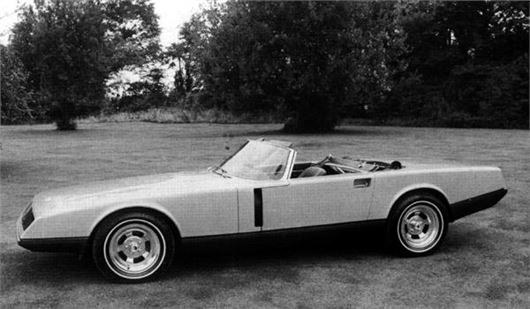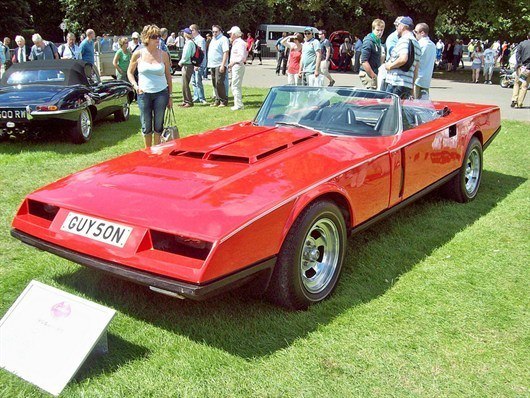Curios: Guyson E12

Dating from 1974, this archetypal William Towns design was essentially a re-clothed Jaguar E-type. Stunning to look at, but just two were made...
Razor-edged Jaguar
One stormy night in 1972, hill-climb champion Jim Thomson – who was also managing director of shot-blasting equipment manufacturer Guyson International – lost control of his Series III E-type Jaguar on a country road near Wetherby in Yorkshire. Most people would have surveyed the damage, contacted their insurers and either arranged to have the damage repaired or visited a local showroom to order a new car. But Thomson had other ideas. He commissioned William Towns to come up with a completely new body for his beloved car.
Towns set about his task by firstly removing the damaged bonnet and the still-pristine bootlid, and then caked the remaining front and rear bodywork with the kind of clay used in styling studios when honing prototypes. He then skillfully crafted the shape he had defined in his intial drawings (bottom). Next stage was to make a set of moulds from the resulting pseudo-prototype, from which a set of glassfibre body panels was created.

Guyson E12 at the 2011 Goodwood Festival of Speed
If the owner so desired, the car could be returned to its standard form by removing the glassfibre panels, refitting the original bonnet and bootlid – and making good any superficial damage incurred by the method of attachment.
These panels were then attached to the E-type’s bodywork by means of screws and resin, leaving the car’s basic superstructure (and most of its original panelwork) entirely intact. Indeed, if the owner so desired, the car could be returned to its standard form by removing the glassfibre panels, refitting the original bonnet and bootlid – and making good any superficial damage incurred by the method of attachment.
The car was finished in yellow, and then passed to Jaguar tuning supremo Ron Beatty, who rebuilt its engine to give an output of around 345bhp, achieved with the help of six 44mm Weber LDF carburretors which unfortunately were so big that a hole had to be cut in the top of bonnet so that they could poke through. Nevertheless, when Thomson finally took delivery of his new creation in 1974, he was suitably impressed.
And he wasn’t the only one: when he stopped at a motorway service station, he reportedly returned to his car to find a man from Jaguar 'drooling over it', and bemoaning the fact that his own company produced nothing like it. Imagine his surprise when he learned that this was little more than a rebodied E-type (although one can’t help feeling that the distinctive E-type windscreen should have been a dead give-away).
Motor magazine was also impressed: it tested the Guyson E12 against a Ferrari Daytona (costing over four times as much as a standard E-type with the engine upgrade) and the Guyson promptly came out on top. Meanwhile, for Fast Car, simply beholding the car was privilege enough, likening Town’s reinterpretation of the E-Type to one of Rachmaninov’s sublime variations on a theme of Paganini…
It has to be said that Towns himself was also much-enamoured of his latest design, for he wasted no time in applying the same conversion to his own E-type, this time finishing it in blue; he decided to forego the engine upgrade, though, no doubt uneasy with the effect it would have on the sleek lines he had devised for the car. He also had it in mind to offer the conversion commercially for around £2000 on top of the E-type’s £3300 list price, but decided against this as the car was by this stage on the verge of being replaced by the XJ-S.
Little could he have known back then that one day he would undertake a similar rebodying exercise on the X-JS itself…

Compare classic car insurance quotes and buy online. A friendly service offering access to a range of policies and benefits.


 Keith Adams
Keith Adams
 NEC classic motor show 2020 postponed due to Covid 19 concerns
NEC classic motor show 2020 postponed due to Covid 19 concerns
 Classic car auction house Coys goes into administration
Classic car auction house Coys goes into administration
 Motor racing great Sir Stirling Moss dies aged 90
Motor racing great Sir Stirling Moss dies aged 90
 Alfa Romeo anniversary races set for Silverstone
Alfa Romeo anniversary races set for Silverstone
 Government to make E5 fuel available for classic owners
Government to make E5 fuel available for classic owners
 Plans to introduce cleaner fuel could damage more than a million classic cars
Plans to introduce cleaner fuel could damage more than a million classic cars
 Top 10: Classic cars from the Gulf motor racing heritage collection
Top 10: Classic cars from the Gulf motor racing heritage collection


